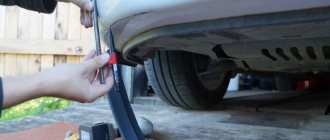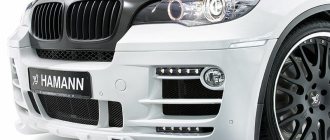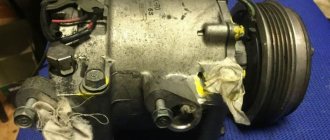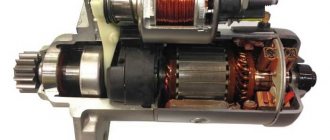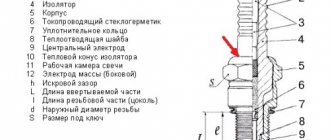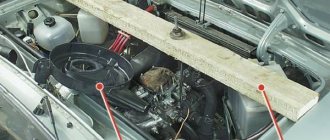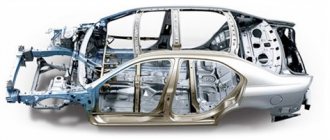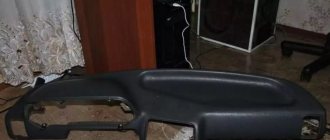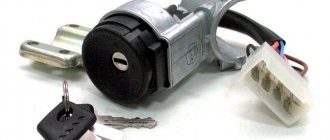The car suspension is one of the main components of the chassis system, due to which the car moves. One such example is MacPherson suspension, which can sometimes be found on cars with front-wheel drive. This is one of the most common types of independent suspension, and is also not very demanding in terms of spare parts and breakdowns. We can also say that McPherson is a developed type of double wishbone suspension, in which engineers installed a shock absorber strut instead of an upper wishbone.
Due to its compact structure and small number of parts, the MacPherson strut suspension allows the engine and transmission to be positioned transversely, and the torque is usually transmitted to the front axle of the vehicle. Another advantage of McPherson is its large stroke, which allows it to prevent breakdowns. Let's take a closer look at the suspension design, characteristics and capabilities in pros and cons.
History of creation
1948 Ford Vedette
This suspension was developed based on the double wishbone suspension used in the 1940s.
Ford engineer Earl McPherson developed and put his invention into mass production. A solution that simplified the design of the suspension with two wishbones was the use of a load-bearing shock absorber strut. A characteristic feature was the presence of a spring in its upper part. When assembled, the structure was a single whole. This eliminated the need to use an upper lever. The first production car with this front suspension design was the 1948 Ford Vedette. Later, modified versions began to be used on other cars of the concern. In the 70s, McPherson's idea was picked up by other automakers. The type of pendant was named after its creator.
Sources and notes
- ↑
- . Retrieved August 16, 2006.
- Setright, L. J. K., "MacPherson Strut: Legs to Support the Car", in Northey, Tom, ed. World of Automobiles
(London: Orbis, 1974), Volume 11, p.1235.
The VW Golf III (MK3 “Modification Kit 3”) is a compact car produced in Germany by Volkswagen from 1991 to 2002. Body types: three-door and five-door hatchbacks, Golf Variant station wagon, Vento sedan and convertible. First presented to the general public at the 1991 Geneva Motor Show. From the spring of 1992 until the end of production, the car was sold in Russia and the CIS countries, but sales of the car were small.
In the fall of 1992, the car took 1st place in the ranking of professional European journalists and became the European Car of the Year. In the 2000s, several tens of thousands of used VW Golf III cars were imported into Russia from Western countries (Germany, Belgium, Holland, Sweden, Switzerland and the USA).
The total number of cars produced was 4,805,900, including 222,626 station wagons and 43,902 sedans.
In 1998 it was modified and became a little modernized. But in the same year the next generation appears.
Coilover is an element of an automobile sports suspension. This part of the car's chassis consists of a shock absorber with the ability to adjust the stiffness and a spring on a screw bushing, which allows you to adjust the vehicle's ground clearance by compressing the spring. The shock absorber and spring are a single unit and are installed on the car as a replacement for standard components. The main purpose of coilovers is to lower the car's suspension, thereby changing its appearance and behavior on the road. Depending on the model and manufacturer of coilovers, you can reduce the vehicle's ground clearance by up to 80 mm. This type of sports suspension is widely used on both cars and motorcycles.
There are two types of coilovers. One of them allows you not to change the standard shock absorber by installing a screw thread and a spring with changed characteristics on it. The second type is a single part, which includes a shock absorber, spring, bushing, and support bearing.
Suspension device
The MacPherson suspension has become widespread thanks to a very simple device with a small number of components.
Its design includes:
- Body brackets or subframe;
- Lower arm;
- Shock absorber strut;
- Upper support;
- Elements that provide movable connections (rubber elements, ball joints).
These are components of only one wheel. On one axle, two sets of the listed components are used for its two wheels. But there is another component that connects the suspension of the left and right wheels - a stabilizer bar, which at its ends is attached to the struts or levers, and in the central part to the subframe or body.
MacPherson suspension elements
The MacPherson suspension design is very simple. In the lower part, the wheel hub is attached by a movable connection to the body by means of a transverse lower arm. A vertically located shock-absorbing strut is also attached to the hub (although not strictly vertically, but at a certain angle). In the upper part, this rack rests against the body and is attached to it by means of a support. That's the whole design of this independent suspension.
Steering knuckle with hub
Now a little about each component of the suspension. For fastening to the body, brackets are provided in the lower part, which are ordinary eyes, to which transverse arms are attached by means of a bolt connection. But in order to ensure reduced transmission of vibration to the body, the lever is fastened through rubber-metal spacers - silent blocks. These brackets can be made both on the body itself and on a subframe - a tubular structure attached to the load-bearing part.
The simplest version of this suspension uses only one lower wishbone, which is attached at one end through a silent block to the body, and at the other end to the hub via a ball joint. Additionally, a stabilizer is attached to this lever, also through a silent block. But this design does not provide adequate rigidity with respect to the longitudinal displacement of the wheel.
Therefore, more modern MacPherson suspensions use either two wishbones installed at a certain angle relative to each other, or one, but A-shaped. This solution somewhat increases the number of attachment points, and therefore the places where vibration can occur, but it ensures proper fixation of the wheel from longitudinal displacement. In such designs, if the stabilizer is attached to the lever, it is not directly, but through a special rack. But many automakers fix the ends of the stabilizer to the strut body through rods.
The shock absorber strut is the main element of the MacPherson suspension, since its task is to dampen oscillatory movements and reduce their transmission to the body as much as possible. It consists of a housing, through which it is attached to the hub, a spring and a shock absorber. The classic design is a strut, in which the shock absorber and housing are located inside the spring, although there are also designs with an external spring.
MacPherson gas-oil strut device
In the upper part, the rack is secured by means of a special support, against which a spring rests. Often, the support design uses a bearing, which allows the rack to rotate around its axis. What achieves another positive property of this type of suspension is the ability to use it as a steering knuckle.
Earl McPherson's Secrets
The first independent suspensions appeared at the dawn of motoring, but elements of the MacPherson suspension were already clearly visible in them. The Sizaire suspension design from 1905 is practically a copy of this design. Only there were no shock absorbers. Haven't figured it out yet. And the strength of the old suspension could not be ensured by the technologies of that time. Therefore, for some time they forgot about her. They used spring suspension and did not blow their minds until, in 1922, the Italian company Lancia relegated springs to the background. This was another incarnation of the pivot strut, which had damping functions. That Lancia's strut was both a pivot and a vibration damper, and the combination of a spring and a shock absorber in one block was used for the first time in the world. So McPherson is not the first here either.
Pros and cons of MacPherson suspension
As with every device, MacPherson suspension has its pros and cons in comparison with other subtypes of independent suspensions. First, let's look at the main advantages that engineers and specialists most often highlight, since this suspension is widespread on modern cars:
- Reliability and simplicity of the design itself provide a very long service life;
- Versatility, MacPherson suspension works perfectly on both the front and rear axles of the car;
- Relatively low production cost. A small number of components makes this suspension the most accessible and inexpensive;
- Small sizes. Due to the small number of parts, it can be used even on the most compact cars;
- Suspension travel with a large margin. Due to this reserve, the likelihood of a breakdown of the suspension or transfer of impact energy to the car body is reduced;
- Reduced load on moving suspension elements. The main force is taken by the stand, but ball joints and silent blocks ensure the mobility of the mechanisms, due to which they have received a good reserve of service life.
Despite these advantages of the MacPherson suspension, there are still disadvantages that have played an important role in their widespread use on all cars:
- Difficulty in maintaining the shock absorber strut. To replace one part or carry out maintenance on other components, it is necessary to completely remove the entire structure, but for disassembly you will need a special tool, since it is not so easy to compress and release the spring;
- Constant load on the rack. It is this factor that affects the service life of the suspension; as a rule, it is proportional. The greater the load, the shorter the service life;
- Wheel alignment and kinematics. In the case of a long stroke of the shock absorber strut, the toe-in angles change over a wide range. As a result, the vehicle's stability and controllability decrease and tire wear increases;
- Strengthening the attachment point on the body of the upper part of the shock absorber strut. We can say that this part of the body can withstand overloads the most; if not strengthened, cracks or corrosion may appear;
- Increased operating noise. Due to noisy mechanisms, MacPherson suspension is not used on premium cars; most often, preference is given to the multi-link version. This type of suspension ensures quiet and smooth movement of the car body.
Considering the pros and cons of the MacPherson suspension, they still decided to use it on many production cars as one of the options for independent suspension. Cheap, simple and reliable, which makes it popular. In addition to the standard set, there are also modified options. In this case, instead of a standard shock absorber, the manufacturer installs a hydropneumatic shock absorber.
Due to this modification, you can change the stiffness of the suspension and install an additional ball joint on top. In turn, this affects the improvement of handling when driving over uneven roads.
Six MacPhersons to choose from
Holy simplicity turned out to be quite a sought-after commodity. Only 50 years have passed since the development of the design of the most commercially profitable suspension, but today we can say that no matter what cars the design was installed on, not a single car failed in the market due to its fault. Even the most budget ones. In this regard, Fiat blocked everyone by installing an amazingly economical design on the Panda model. On Panda there is not even a lever in the full sense. A spring strut with a monotube shock absorber rests on top of the body, and from below it is held by a torsion bar anti-roll bar and a tiny swing arm, which is attached to the strut with a simple bolt. Even easier than eight. In general, over the years we can already distinguish six types of MacPherson suspensions. Since engineers have not yet given them names, we will allow ourselves to come up with our own terminology.
After General Motors, McPherson went to work for Ford
Macpherson classic
Exactly the one that rocked the Ford Consul in 1949, a similar one is installed on the VAZ. The design is distinguished by a narrow lower arm, which is tightly attached to the anti-roll bar. At the same time, both the pros and cons of this design are that the stabilizer took on too much. In addition to its main functions, it also served as an additional arm of the lower lever, preventing the car from moving to the side during acceleration and braking.
MacPherson wishbone
This scheme appeared in the early 70s on Kadett E cars. A durable triangular lever was attached not to the body, but to the subframe. The subframe hung on rubber silent blocks, absorbing all road vibrations, making the front suspension as comfortable as possible.
Nemacpherson
MacPherson, but not quite, since the short spring was installed separately from the shock absorber. The shock absorber still rested against a cup welded to the body on the wheel arch. This treacherous design proved to be much more durable than the real MacPherson. The 124th and 201st Mercedes were equipped with exactly this configuration, and the Ford Transit jumped from this design only in 2001. Reliability was ensured precisely by reducing the load on the upper support part, so you will never see a Transit with a broken support part in the upper wheel arch cup.
Springless
It’s hard to say what to call this MacPherson, since it has no springs at all. The cunning Italians instead used longitudinal torsion bars on the Fiat 130. Torsion bars, by the way, were also expected by Zhiguli, if not for the chief designer MZMA, who was part of the Fiat acceptance committee. He seriously quarreled with the Italians about this and about the lower engine, which the Italians wanted to sell to Soviet burly reception engineers. But the point is not that, but the fact that in the Mercedes Sprinter and Volkswagen LT in the 90s, this type of MacPherson was used, only with a transverse spring.
American MacPherson
This type is used only on the rear suspension. There are as many as three levers working here - one transverse and two longitudinal. Almost all front-wheel drive Americans of the 80s and 90s have such a rear suspension, and some Koreans and Japanese are not far behind them.
MacPherson Renault
This is definitely the correct name, since this scheme is used only on these French cars. To avoid all the MacPherson's handling shortcomings, of which there are plenty, the French used a kingpin. Such as on the Volga. Just not that threaded, creaking nightmare, the design turned out to be more elegant. The stand here is non-rotating, and the wheel and knuckle rotate, held in place by ball joints.
How it works
The MacPherson suspension works like this: when hitting a bump, the wheel moves vertically relative to the body and this is ensured by a strut (due to spring compression) and a lever attached by movable joints to the hub and the load-bearing part.
The spring perceives the force, but it is not able to quickly extinguish it, and here the shock absorber comes into play, which absorbs all the energy.
When hitting a bump, a force also arises that tries to move the wheel itself in the longitudinal direction. Such a negative effect is “fighted” by two levers installed at an angle or one A-shaped one, in which two peaks are attached to the body and only one to the hub.
After overcoming the unevenness, the spring takes its original position, due to which the wheel, relative to the body, is aligned.
When overcoming bumps, both wheels move independently of each other. But at the same time, the suspension is not able to completely absorb all the forces and some of them are still transferred to the body. In this case, there is a possibility of swinging of the load-bearing part if both wheels move on uneven ground.
To prevent this from happening, an anti-roll bar is used, connecting two independent suspensions of the same axle. It is a regular torsion bar and, due to the emergence of forces that counteract torsion, it is able to dampen the oscillatory movements of the body.
History of invention and development
The name of the design uses the name of the inventor, an employee of Earl Steel McPherson. This type of suspension was first used on the production Ford Vedette after World War II in 1948. The engineer initially worked at GM's design bureau on the Chevrolet Cadet, a consumer vehicle.
The model did not go into production, and the designer went to competitors, where he applied his own developments. In fact, suspensions of this type with a slightly different configuration without a transverse swing arm were used at the dawn of the automotive industry.
In the 20s of the last century, the Italian engineer Guido Fornaza developed a circuit diagram and patented it in the United States on September 15, 1925.
The layout looked familiar to us with a lower swing arm and a rotating vertical stand. The American designer Earl Steel McPherson used the general operating principle, modified it and implemented it in metal. The main difficulty at the initial stage was the low service life of the telescopic stands. With the development of technology, this problem was solved.
Initially, this type of suspension was planned to be used not only in the front of the car, but also in the rear. After much discussion, the choice was made in favor of the traditional scheme. This type of rear wheel suspension was first used in 1957 by Colin Chapman on the Lotus Elite model. Due to this circumstance, in the New World and Great Britain this design scheme is usually called the Chapman type suspension.
An alternative version of the history of the development of suspensions of this type can be considered a design with two levers of different lengths. The upper unit was significantly shorter than the lower one, and the springs with shock absorbers were located above them. This scheme is used in the all-wheel drive Niva; the shaft with an external constant velocity joint is located just between the levers.
Signs and malfunctions of MacPherson suspension
The first and very noticeable malfunction is the rocking of the car body
. The main sign that the shock absorber struts are exhausting their service life and are becoming unusable. The result is loss of comfort, deterioration in vehicle handling, as well as accelerated wear of related suspension parts.
Cars equipped with ABS and ESP
, in the event of a breakdown, the suspensions begin to operate and signal more often. As soon as your “iron horse” begins to nod or sway, you should not put it off until later. The result of such breakdowns is a proportional increase in braking distance; the greater the breakdown, the slower the car will stop. Accordingly, the safety of the car is lost.
Loss of directional stability
Another reason why you should pay attention to your car's suspension. The failure or weakening of one of the shock absorbers leads to a decrease in the vehicle's support on all 4 wheels. Thus, when entering a turn, the car simply skids; the very slipping of any axle indicates a possible breakdown.
At least once in their life, every driver has felt a car nodding or throwing up its rear.
. This usually leads to poor health, decreased attention, or much more dramatic consequences of such a breakdown. This is another sign of failure of the car’s shock absorbers; the very rocking and incorrect distribution of the car’s weight is felt during sudden acceleration or braking. There is no way to sit comfortably in such a car, and besides, all this harms the body structure.
Reducing ground clearance
it is also a sign of failure of one of the suspension parts, unless of course you are a supporter of “lowered” cars, and the car’s suspension has not been modified. There can be several reasons for such a breakdown, tired metal, corrosion of one of the parts. Most often, the springs can sag (they shorten the compression stroke), due to which the entire force of the impact is transferred to the body and interior of the car, and the connections and joints on the body and interior expand.
Uneven tire wear and excessive hardness
, it is with these indicators that most problems with the suspension begin. You can see tire wear with the naked eye, and the stiffness will be noticeable when driving on uneven roads. For MacPherson suspension, this is a very common phenomenon, due to a floating wheel angle (impaired wheel alignment) or sagging of the shock absorber strut as a whole.
McPherson suspension – good for everyone, not so much for us
MacPherson suspension device problems
Here's a little more about this. Today, on the vast majority of cars, the front independent suspension (and often the rear) is made according to the McPherson scheme, named after the engineer who allegedly first proposed it.
The essence of the scheme is simple, elegant and technological:
- The spring is placed coaxially on the shock absorber and forms a so-called strut.
- The upper end of the shock absorber is attached to the body through a rotating strut support, the lower end is attached to the steering knuckle of the hub assembly.
- The hub assembly itself is connected to the car body using a lever, most often triangular, or rather, three-point.
- Due to the fact that the strut support contains a powerful rubber silent block and a bearing, the strut itself can rotate around its axis under the influence of the steering, and the silent block allows the strut to swing when the car overcomes an obstacle. Therefore, the second name for McPherson type suspension is “swinging candle”.
The mathematical model of the MacPherson suspension divides its elements into three groups:
- Elastic elements.
- Vibration dampers.
- Connections (links).
Elastic elements include:
- Springs,
- springs,
- rubber silent blocks,
- rack supports, etc. - that is, everything that is compressed/decompressed many times.
Connections include:
- Tractions,
- ball joints,
- levers,
- mounting bolts and nuts.
But this is in pure theory. In reality, each element can belong to several groups.
For example, many silent blocks are both elastic elements and connections; the spring is an elastic element with vibration damping properties, and the strut is both a vibration damper and a coupling element
In 1965, the victorious march of McPherson began after it was installed on the Peugeot 204. The decisive success of this type of suspension is due to its high manufacturability and ease of use on car manufacturers' assembly lines. But McPherson, for all its advantages, has a serious drawback - the strut, in addition to being a vibration damper, also serves as a power element for the McPherson suspension.
On good roads in Europe, America and Japan, this drawback does not particularly interfere, but in our “directions” everything is not so smooth. Let's say a wheel falls into a very large hole and, upon exiting, “bumps” into its edge. The stand deviates from its usual position and crushes the rubber of the silent block of its upper support. At some point, the compression reaches its maximum, and the rubber has nowhere to compress. The bending force is transferred to the strut shock absorber body, attempting to break it.
This is where McPherson struts come from with bent rods, torn out oil seals, etc. For bad roads, it is much preferable not to McPherson, but to a multi-link suspension, which is much less common. In addition, McPherson's dynamic camber angle fluctuates greatly during compression and rebound strokes.
Suspension components
Shock absorber
It is a shock absorber with a coil spring installed on the body. The spring is sandwiched between the lower and upper cups. The upper shock absorber support is fixed to the body in a special niche under the car's wing. The rotation of the wheel is carried out due to the bearing integrated into it. The bottom of the MacPherson strut connects to the hub assembly. The stand is not installed vertically, but at a certain angle to the car wheel in the transverse plane. This angle is called king pin angle or KPI and has a big impact on the vehicle's handling. This parameter is not adjustable and is included in the suspension design during design.
Lower wishbone
A guide element that provides vertical movement of the suspension. It has two attachment points to the body subframe. Less common is the option with one fastening, with the second point being duplicated by a longitudinal (reactive) thrust. Through a ball joint, it secures the wheel hub in its lower part.
Anti-roll bar
An elastic curved metal rod attached to the subframe and both arms. Designed to level the lateral roll of the car. When turning, the side with less inclination supports the opposite one.
Design Features
The suspension from a design perspective is characterized by simplified kinematics. Its compactness is due to the replacement of the upper arms with shock-absorbing struts. When designing the suspension, the goal was to achieve compactness of the device, simplicity of design and low cost of production, so comfort and controllability were relegated to the background.
Initially, the suspension design raised some doubts. It was assumed that unacceptable wheel vibrations could occur in the camber plane. These fears were not confirmed. The amplitude of oscillations corresponded to normal values. At the same time, tire wear has become more uniform.
After the suspension was put into production, McPherson continued to work on his “brainchild,” trying to make the product even cheaper. He did not succeed in this, since cheap materials did not allow him to provide the appropriate suspension strength characteristics.
The difference between a shock absorber and a shock absorber
Shock absorber is a damping element of the suspension designed to dampen vibrations. The shock absorber strut, in turn, consists of a shock absorber and a spring. Thus, in addition to design features, the rack performs many more functions, namely, it is simultaneously a load-bearing, elastic and damping structural element.
Suspension strut
The difference between a strut and a conventional shock absorber:
- It is a more complex mechanism.
- It has a reinforced structure and a larger rod diameter.
- It is an elastic element that absorbs loads from the road surface.
- Supports the weight of the car.
- The rotary support of the shock absorber is involved in turning the wheels of the car.
- Resists axial and lateral loads.
Purpose of individual nodes
The lower arm is capable of performing large amplitude oscillations relative to the support points - silent blocks.
Silent blocks are consumable materials made of rubber and metal, and must be replaced as they deteriorate. The ball joint ensures rotation of the steering knuckle with the hub relative to the vertical axis, regardless of the angle of inclination of the lower arm. This load-bearing element of the MacPherson strut suspension requires close attention. If play occurs, the support must be replaced.
The spring serves to dampen vibrations. It is quite durable, but over time, the metal from which the spring is made loses its properties and a weakening of rigidity is observed. This manifests itself in an increase in the amplitude of vibrations and a lowered landing of the car.
The shock absorber is based on two cylinders. When one moves relative to the other, fluid flows. Designed to dampen spring vibrations. The shock absorber experiences very heavy loads, especially in extreme positions. This may damage the bypass valves. The stand is failing. Symptoms are oscillations that do not die out over a long period of time.
Ultimately, the entire shock when driving over uneven surfaces will be transferred to the support and support bearing . It is not difficult to guess what requirements are imposed on the design and material of these units.
MacPherson type rear suspension
On vehicles with independent rear suspension, the MacPherson arrangement is also used. However, it was already developed by another designer named Chapman. His name is often used in the title. The principle of operation and device are similar to the front one.
Rear independent MacPherson suspension
Advantages:
- It is lightweight due to less load on the rear of the car.
- Allows for improved overall handling.
- It has the constructive ability to implement wheel rotation. Relevant for a number of cars with steering rear suspension.
Despite the existing shortcomings, suspension based on guide struts is optimal for most middle-class passenger cars. Some of the decisive advantages remain production cost and maintainability.
Expensive cars
Today MacPherson is not a part of the design of expensive cars, but this was not always the case. Since 1982, it began to be installed on prestigious cars, for example, such as the Mercedes 124 and Audi 100. Most cars under the BMW brand were also equipped with this device. For a certain period of time, measured in years, this approach was justified.
Then the automotive industry moved far ahead and the MacPherson suspension no longer corresponded in its technical parameters to what was required for expensive cars: high-quality kinematics that ensured a smooth ride acceptable in accordance with the new requirements. To this we can add that expensive cars and cheap parts are incompatible concepts. Currently, MacPherson strut suspension is used only in budget cars.
